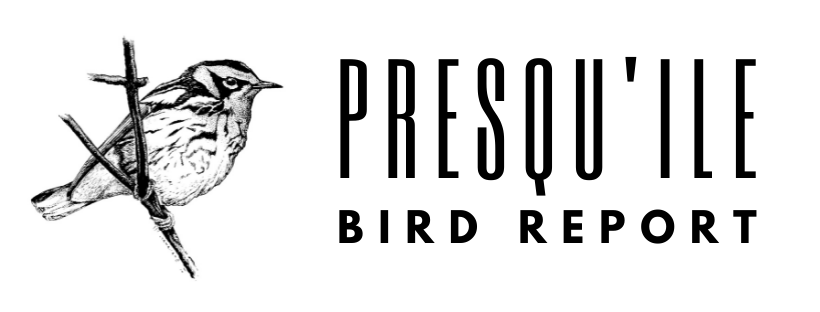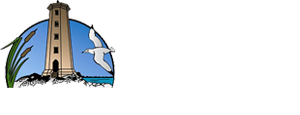
HIGHLIGHTS: NORTHERN SHRIKE, CAROLINA WREN, BROWN THRASHER, CHIPPING SPARROW, PINE GROSBEAK, EVENING GROSBEAK
The bitter cold continued to freeze up the quiet water in the marsh and in general, put a damper on bird (and birder) activity. A few lingering birds persist but in general it is feeling like winter birdlife is now upon us.
Puddle ducks have decreased greatly with the freeze but up to 8 GADWALL and 6 AMERICAN BLACK DUCKS were still around Gull Is. on 18 Nov. Diving ducks put on a good show with notable finds being 2 male CANVASBACK and a RING-NECKED DUCK in a flock of 1400 REDHEAD off the Government Dock on 19 Nov. Both SCAUP were noted with GREATER being most common. All three SCOTERS were seen this week with WHITE-WINGS at various sites all week, a SURF at the Lighthouse on 19,20 and 22 Nov, and BLACK SCOTERS with 3 at Gull Is. on 18 Nov and 2 on 19 Nov at the Lighthouse. Two HORNED GREBES were off the Calf Pasture on 19 Nov. A lone DOUBLE CRESTED CORMORANT was seen at Calf Pasture on 18 and 19 Nov.
A BALD EAGLE was seen on 22 Nov, a NORTHERN HARRIER on 18 Nov, SHARP-SHINNED HAWK on 17 Nov, and RED-TAILED HAWK on 17 and 19 Nov. The only shorebirds reported were 2 SANDERLING and 3 DUNLIN on the beach on 18 Nov. A handful of BONAPARTE’S, RING-BILLED and GREAT BLACK-BACKED were among the more common HERRING GULLS. SNOWY OWLS were seen at Gull Is. and the Woodpile marsh through the week and a BARRED OWL was seen several times north of the Pioneer Parking area.
The “usual” WOODPECKERS (RED-BELLIED, HAIRY, DOWNY and PILEATED) were seen throughout the week at various sites. A male AMERICAN KESTREL was seen on lower Huff Rd., just NW of the gate, on 18 Nov. MERLINS were seen several times through the week. NORTHERN SHRIKES arrived from the muskeg this week with singles on 18 Nov, 20 Nov and 21 Nov. Three COMMON RAVENS were feeding on carcasses on Gull Is. on 18 Nov. Two HORNED LARKS were also on Gull Is. on 18 Nov. The long-staying CAROLINA WREN near the Lighthouse was last seen on 17 Nov but may still be around. A late BROWN THRASHER continues to visit a Bayshore Rd feeder daily. A few SNOW BUNTINGS were seen this week, mostly on Gull Is., but not as many as might be expected.
No warblers were reported this week for the first time. Sparrows have thinned out too but of interest was a CHIPPING SPARROW near the Lighthouse on 18 Nov, a FOX SPARROW there the next day, and a SWAMP SPARROW at the gate on 18 Nov. A small number of WHITE-THROATED SPARROWS were noted at feeders among the more common DARK-EYED JUNCOS and AMERICAN TREE SPARROWS. A RUSTY BLACKBIRD was noted at a Bayshore Rd. feeder on 17 Nov, among the handful of remaining RED-WINGED BLACKBIRDS and COMMON GRACKLES. Finches were well represented. A PINE GROSBEAK on 20 Nov was the first here in several years and hopefully heralding more to come. HOUSE and PURPLE FINCHES were seen in small numbers, mostly around feeders. A single COMMON REDPOLL was flying over the gate on 18 Nov. PINE SISKINS have become quite scarce again with 11 on 17 and 19 Nov and a single on 20 Nov. EVENING GROSBEAKS continue, again mostly at feeders, with a high of 30 on 17 Nov, plus 2 on 19 Nov and 10 on 20 Nov.
The Presqu’ile Christmas Bird Count will be held on Sunday, 16 December. If anyone would like to take part, please contact me privately.
Note that fall waterfowl hunting in now occurring in the Park which means park users cannot go to Owen Pt., the islands, the marsh (boardwalk is open), or Calf Pasture Pt. on Saturdays, Mondays, Wednesdays or Fridays even if no one is hunting on those days. This restriction will last until mid December so plan your trip accordingly.
Directions: Presqu’ile Provincial Park is located on the north shore of Lake Ontario, just south of the town of Brighton. It can be reached from either Hwy. 401, or Cty. Rd. 2 and is well signed. A Park map can be found in the information tabloid available at the Park gate. Presqu’ile’s two offshore islands – Gull and High Bluff – support a large multi-species colonial bird nesting area and access is not permitted during the breeding season (10 March-10 September).


